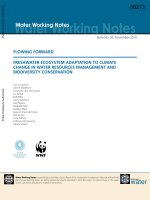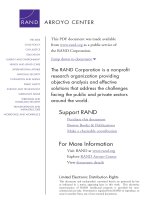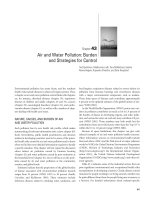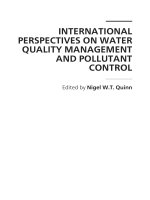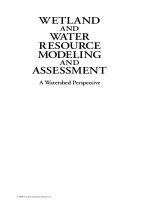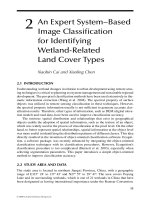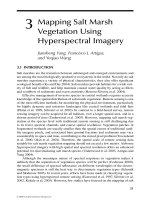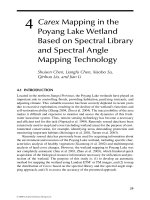Water resource management and utlization for phu quoc islands tourism
Bạn đang xem bản rút gọn của tài liệu. Xem và tải ngay bản đầy đủ của tài liệu tại đây (4.52 MB, 77 trang )
WATER RESOURCE MANAGEMENT AND UTILIZATION FOR PHU QUOC
ISLAND’S TOURISM
____________________________________
A Project
Presented to the
Faculty of
California State University, Fullerton
____________________________________
In Partial Fulfillment
of the Requirements for the Degree
Master of Science
in
Environmental Studies
____________________________________
By
Nguyen H. Le
Approved by:
Professor Jeff Kuo, Ph.D., P.E.
Department of Civil and Environmental Engineering
Date
ABSTRACT
Phu Quoc Island lies in southwest Viet Nam, 40 km offshore from Ha Tien, 2.6
km from Cambodia, 700 km from Malaysia, and 540 km from Thailand. With such a
strategic location, Vietnamese government has been aware of Phu Quoc Island’s role in
the process of development and integration of Viet Nam in particular and Asia – Pacific
Ocean in general into the world. The strategy of Vietnamese government is that by 2020,
Phu Quoc Island must become open economic zone, a new Singapore of Viet Nam. The
strategy has been a special concern for scientific researchers, foreign and domestic
investors, and business people. Phu Quoc is located in the Gulf of Thailand and
surrounded with seas. At present, the ecological environment of Phu Quoc Island is still
deserted and thus Phu Quoc Island’s tourism starts to gain more attention. Water resource
for its tourism has been an exigent issue. The project named “Water Resource
Management and Utilization for Phu Quoc Island’s Tourism” is, therefore, a priority in
the author’s choice in such a setting of Phu Quoc Island.
ii
TABLE OF CONTENTS
ABSTRACT...................................................................................................................
ii
LIST OF TABLES.........................................................................................................
vi
LIST OF FIGURES ....................................................................................................... vii
LIST OF GRAPHS ........................................................................................................ viii
ACKNOWLEDGMENTS .............................................................................................
ix
Chapter
1. INTRODUCTION AND SOME CONCEPTS RELATED TO WATER
MANAGEMENT...........................................................................................................
1
Introduction...........................................................................................................
The rationale for the project ..........................................................................
The objective of the project ...........................................................................
Meaningfulness of the project........................................................................
Framework of the project...............................................................................
Literature review............................................................................................
Approach theory and methodology................................................................
Basic Concepts About Environmental Management ............................................
Environmental management ..........................................................................
Some fundamental issues in environmental management .............................
Organizing environmental management........................................................
Scientific Foundation of Environmental Management.........................................
Philosophical foundation of relationship between human, society, and nature
Scientific and technological foundation of environmental management.......
Tools for Environmental Management .................................................................
Concept about environmental management tool ...........................................
Categorizing environmental management tool ..............................................
1
1
2
2
2
3
5
5
5
6
6
8
8
8
10
10
10
2. NATURAL GEOGRAPHY AND SOCIAL ECONOMICS OF PHU QUOC
ISLAND ....................................................................................................................... 13
iii
Natural Geography of Phu Quoc Island................................................................
Geographical position/topography.................................................................
River system and vegetation ..........................................................................
Climate...........................................................................................................
Social Economics of Phu Quoc Island..................................................................
Demographics ................................................................................................
Economy ........................................................................................................
Transportation................................................................................................
13
13
15
15
16
16
17
19
3. CURRENT STATE OF MANAGEMENT AND USING WATER RESOURCE
FOR TOURISM ON PHU QUOC ISLAND ................................................................. 21
Tourism on Phu Quoc Island ................................................................................
Tourists ..........................................................................................................
Facilities for tourism......................................................................................
Tourism products ...........................................................................................
Water Quality of The Area ...................................................................................
Local water demand.......................................................................................
Water quality of the area................................................................................
Some criteria for water standard....................................................................
Water Capacity of The Island ...............................................................................
Activities That Can Pollute Water Resource and Decrease Water Capacity........
Fishery ...........................................................................................................
Tourism..........................................................................................................
Seafood processing ........................................................................................
Not treated waste water..................................................................................
Groundwater over-extraction.........................................................................
Cua Duong disposal site ................................................................................
21
21
23
25
26
26
28
30
34
34
34
34
36
36
37
37
4.
CONCLUSION, SOME SOLUTIONS AND SUGGESTIONS FOR THIS
ISSUE .......................................................................................................................
39
Conclusion ............................................................................................................
Water capacity ...............................................................................................
Water quality..................................................................................................
Other problems that affect water resource.....................................................
Solutions and Suggestions ....................................................................................
Policy tool ......................................................................................................
Technological tool .........................................................................................
Economic tool ................................................................................................
Supporting tool ..............................................................................................
Further Researches................................................................................................
39
39
39
40
40
40
41
42
42
43
iv
APPENDIX....................................................................................................................
1.
2.
3.
4.
5.
6.
44
Maps of boring locations ...............................................................................
Hydro-geological map of Phu Quoc Island ...................................................
Hydro-geological cross section CD line ........................................................
Chemical characteristics of water ..................................................................
Vertical electrical sound (VES) measure results ...........................................
Geological cross section of borings ...............................................................
44
46
48
49
51
63
REFERENCES ..............................................................................................................
64
v
LIST OF TABLES
Page
Table
1.
Population on Phu Quoc island......................................................................
17
2.
Productivity value of Phu Quoc.....................................................................
19
3.
Number of tourists to Phu Quoc 1995-2005..................................................
22
4.
Residency of visitors at Phu Quoc (1999-2004)............................................
22
5.
Number of hotels and motels at Phu Quoc 1995-2005..................................
23
6.
Number of wells at Phu Quoc........................................................................
27
7.
Chemical components of rainwater in 2005 ..................................................
28
8.
Analyzing result of groundwater samples .....................................................
29
9.
Categories of water based on TDS ................................................................
31
10.
Categories of water based on pH ...................................................................
31
11.
Categories of water based on hardness level .................................................
32
12.
Water quality standard for drinking and eating .............................................
32
13.
Safe drinking water standard for nitrogen compounds..................................
33
14.
Reasons of trash pollution..............................................................................
36
vi
LIST OF FIGURES
Page
Figure
1.
Location of Phu Quoc ....................................................................................
13
2.
Map of Phu Quoc Island ................................................................................
14
3.
Distribution of hotels and resorts at Duong Dong .........................................
24
4.
Trash at the port and oil leakage on the river ................................................
34
5.
Trash at Da Ban Fall ......................................................................................
35
6.
Cua Duong disposal site ................................................................................
38
vii
LIST OF GRAPHS
Graphs
Page
1.
Rainfall on Phu Quoc Island from 2002-2005...............................................
16
2.
Comparison amongst samples .......................................................................
30
viii
ACKNOWLEDGMENTS
This project could not have been completed without Professor Jeff Kuo, who
worked as my project advisor and guide me through the process. Besides, Professor
Nguyen Phat Minh of Department of Geology, University of Natural Sciences, Ho Chi
Minh City is the person who help me to acquire the data for this project. I want to thank
them all.
REFERENCES
Becken, S. & Patterson, M. (2006). Measuring National Carbon Dioxide Emissions from
Tourism as a Key Step Towards Achieving Sustainable Tourism. Journal of Sustainable
Tourism, 14(4), 323-338.
Collier, A. (1999) Principles of Tourism. A New Zealand Perspective. Auckland:
Addison Wesley Longman.
Dang Mong Lan (2001). Environmental management tools. Ha Noi: Science and
Technology Publishing House.
Department of Geography. (2007). Brief report on general view of residential conditions,
tourism economic and environment at District of Phu Quoc. HCMC: Department of
Geography, University of Social Sciences and Humanities.
Department of Geography. (2007). Orientation of strategies of sustainable development
of tourism in Phu Quoc Island to 2020. HCMC: Department of Geography, University of
Social Sciences and Humanities.
Department of Geology and Minerals of Vietnam (2003). Annual report 2003.
ix
Dinh Hong Hai. (2007). Kien Giang tourism. HCM: Van Nghe Publishing House.
Doan Thi Thu Ha, Nguyen Thi Ngoc Huyen (2001). Management science textbook - part
one. Ha Noi: Science and Technology Publishing House.
Le Huy Ba (2000). General Environmental Management. HCMC: National University
Publishing House.
Le Huy Ba, Lam Minh Triet (2000). Basic environmental ecology. HCMC: National
University Publishing House.
Le Trinh (1997). Observing and controlling water environment pollution. Ha Noi:
Science and Technology Publishing House.
Luu Duc Hai, Nguyen Ngoc Sinh (2000). Environmental management for sustainable
development. Ha Noi: National University Publishing House.
National Coporation of General Construction Consultants (2005). General construction
planning of Phu Quoc Island, Kien Giang Province. Ministry of Construction, Vietnam.
Nguyen Duc Khien (2001). Environment and development. Ha Noi: Science and
Technology Publishing House.
Nguyen Khac Cuong (2000). Textbook of environment and environmental protection.
HCMC: University of Technology.
Nguyen Phat Minh (2004). Solution for groundwater recharging in Ho Chi Minh City.
HCMC: Department of Geology, University of Natural Sciences.
Nguyen Thu Cuc, Son Thanh Tung (2007). Report on current situation of Phu Quoc
environment using DPSIR framework. HCMC: Department of Geography, University of
Social Sciences and Humanities.
Nguyen Van Anh, Ngo Minh Kiet, Tran Ngoc Thanh (2005). The prospect of water
supply for Duong Dong Commune, Phu Quoc District, Kien Giang Province. University
of Natural Sciences: Department of Geology.
Phan Thanh Dinh (2002). Researching and promoting procedure for water environment
management at District of Binh Chanh, Ho Chi Minh City. HCMC: Department of
Geography, University of Social Sciences and Humanities.
x
Southern hydrological and meteorological station (2005). Precipitation report 20002005.
Statistic Office of District of Phu Quoc (2006). District of Phu Quoc statistical yearbook
2006.
Tang Van Doan, Tran Duc Ha (2001). Environmental technology. Giao Duc Publishing
House.
Tran Van Huan (1998). Potentials of Phu Quoc in the past and present. Ha Noi: Thanh
Nien Publishing House.
United Nation Development Programme – Project of Vietnamese government. (2003).
The overall scheme on development for Phu Quoc Island’s tourism. Ha Noi.
Van Hoa Online. < />Viet Nam National Administration of Tourism (2005). Summary of the scheme on
development of Phu Quoc Island’s tourism. Ha Noi.
Vietnam Environmental Protection Agency (2005). Report on current situation of
national environment.
APPENDIX 1
Maps of boring locations
xi
xii
xiii
APPENDIX 2
Hydro-geological map of Phu Quoc Island
xiv
xv
xvi
APPENDIX 3
Hydro-geological cross section CD line
xvii
APPENDIX 4
xviii
Chemical characteristics of water
xix
xx
APPENDIX 5
Vertical electrical sound (VES) measure results
xxi
xxii
xxiii
xxiv
xxv
